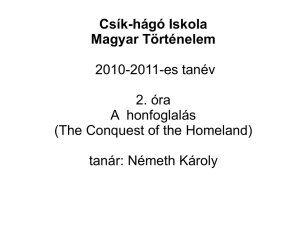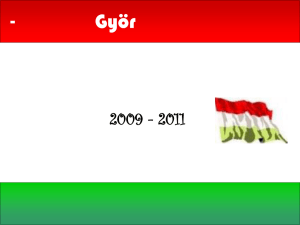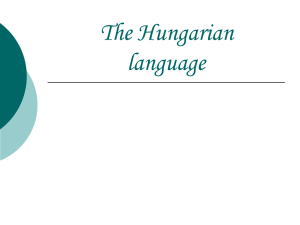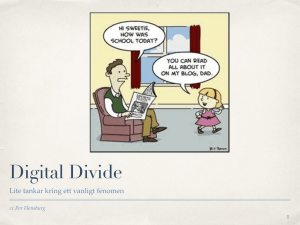A magyar konyha - Csík Hágó Magyar Iskola
advertisement
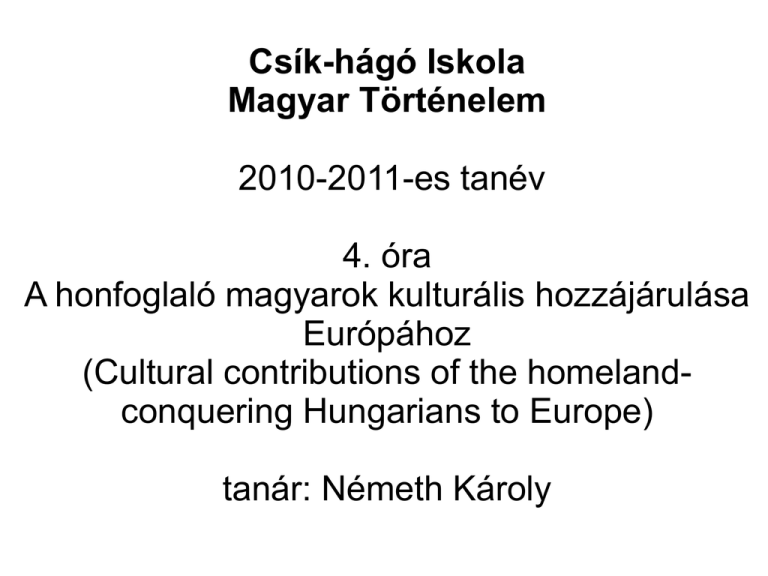
Csík-hágó Iskola Magyar Történelem 2010-2011-es tanév 4. óra A honfoglaló magyarok kulturális hozzájárulása Európához (Cultural contributions of the homelandconquering Hungarians to Europe) tanár: Németh Károly Isten, áldd meg a magyart Jó kedvvel, bőséggel, Nyújts feléje védő kart, Ha küzd ellenséggel; Bal sors akit régen tép, Hozz rá víg esztendőt, Megbűnhődte már e nép A múltat s jövendőt! (“Himnusz”, Kölcsey Ferenc verse (1823)) O Lord, bless the Hungarian nation With your grace and bounty Extend over it your guarding arm During strife with its enemies Long torn by ill fate Bring upon it a time of relief This nation has suffered for all sins Of the past and of the future! (“Hymn”, by Ferenc Kölcsey (1823)) Felhasznált irodalom: Radics Géza: Eredetünk és őshazánk (Magyar kutyafajtákról szóló fejezet) Dr. Cey-Bert Róbert Gyula: A magyar konyha ízei (Áldozati ételek és gasztronómiai civilizációk, Ujgur konyha című fejezetek) http://en.wikipedia.org/wiki/Magyar_agár http://en.wikipedia.org/wiki/Vizsl a http://en.wikipedia.org/wiki/Kuvas z http://en.wikipedia.org/wiki/Kuvas z http://en.wikipedia.org/wiki/Komondor http://en.wikipedia.org/wiki/Hungarian_Grey_cattl e http://hu.wikipedia.org/wiki/Magyar_racka_ju h http://www.turkishcuisine.org/english/article_details.php?p_id=2&Pages=Articles&PagingIndex=1 http://en.wikipedia.org/wiki/Turul http://en.wikipedia.org/wiki/Past a http://en.wikipedia.org/wiki/Egg_barle y http://www.kossuth-saujhely.sulinet.hu/diafilm/main90.htm Sólymászat / falconry A sólymászat ázsiai eredetű szokása Európában előszőr a hunok révén kezdett elterjedni a 400-as években, később a magyarok, bulgarok és az arabok révén is. A kerecsensólyom, másik nevén turul, a magyarok és sok más ázsiai lovas nemzet szent madara. A magyar eredetmítosz egyik központi alakja, lsd Emese álma történet. / Falconry was an Asian custom that started to spread in Europe by the Huns in the 400-s AD, later by the Hungarians, Bulgars and Arabs. The saker falcon, or turul, is a sacred bird of ancient Hungarians and other mounted nomadic Asian nations (Turks, Mongols, etc). It is a central figure of the Hungarian mythology of ethnic origin (ethnogenesis), e.g. in the tale of “Emese's dream”. Turul (saker falcon) Fiókáit tápláló turul, 9. századi magyar jelvényen. Turul, feeding its chicks, on a 9th century Hungarian badge. Kutyafajták, amiket a honfoglaló magyarok hoztak Európába Ázsiából Dogs breeds that were brought by the Hungarians to Europe from Asia Magyar agár / Hungarian agár Agarászat: hosszú távú hajtóvadászat Long distance coursing game http://en.wikipedia.org/wiki/Magyar_agár Magyar vizsla / Hungarian vizsla A honfoglaló magyarok kedvenc vadászkutyája a 10. században. Favorit hunting dog of homeland-conquering Hungarians in the 10th century. http://en.wikipedia.org/wiki/Vizsl a Kuvasz Tenyésztett állatokat őrző kutya / Sheparding / guarding dog Eredete az ősi Mezopotámiáig megy vissza. / Its origin may be in ancient Mesopotamia. http://en.wikipedia.org/wiki/Kuvas Komondor Pásztorkutya, őrzőkutya Sheparding/guarding dog http://en.wikipedia.org/wiki/Komondor Magyar szürkemarha / Hungarian gray cattle A honfoglaló magyarokkal együtt érkezett Ázsiaból a 9. században. Divatos egészséges ételeket készítenek a húsából. / It was brought in to Europe from Asia by the Hungarians in the 9th Century. It is emerging also as a fashionable “whole food” livestock. Racka juh / Hungarian racka sheep A magyar konyha / Hungarian cuisine (felhasznált irodalom/ based on: Dr. Cey-Bert Róbert Gyula: A magyar konyha ízei) Indoerópai népek (német, francia, angol, spanyol, stb.) Indo-European people (German, French, English, Spanish, etc) Ősi tűzimádás, a tűz megtisztító hatása Fire-cult, fire has a sacred purifying power Áldozati adományok megsütése Sacrificed food was grilled on open fire Sűtésen alapuló konyha Preference for grilling/roasting/baking/frying Nem-indoeurópai ázsiai eredetű népek (magyar, finn, török, mongol, kinai, japán, stb ) A víz és a tűz együttes megtisztító hatása Áldozati adományok megfőzése Főzésen alapuló konyha Non-Indo-Europan Asian people (Hungarians, Finns, Turks, Mongols, Chinese, Japanese, etc ) Cult of both water and fire Sacrificed food was cooked Preference for cooking (soups based kitchen) Bor kultura / wine culture A törökös népekkel közös sokezeréves szőlő és borkultura. Pl a Turfan oazisban, Ujguriában a Bor-luk (magyarul Bor-lyuk, feltételezhetően az ősi Ujgur-hun-magyar kapcsolatokon keresztül) szurdokos völgyben több, mint 4000 éves szőlő és bor-kultura található. Az ujgur nyelvben a szőlőskert ősi neve “borluk”. Common with Turkic Middle Asian people, Hungarians had a many thousand years old wine culture. For example in Uyghuria, in the Turfan oasis, Borluk is a centrally located deep valley known for more than 4000 years of wine culture. “Bor” is wine also in Hungarian, and “luk” is a deep valley (perhaps for the ancient Uyghur-Hun-Hungarian relations). The old uyghur word for wineyard is “borluk” . http://en.wikipedia.org/wiki/Turpan Borluk Szőlőlugas / grapewine-trallis shade http://www.turkish- Száraztészta / Dry pasta Legismertebb ősi magyar változata a tarhonya, amit a kalandozó magyarok is vittek az útjaikra (száraz húsporral együtt), gyors ételkészítés céljából. A tésztát (laskát) Ázsiában régebb óta ismerték, mint Európában. Kinában már 4000 évvel ezelött is készítettek száraz tésztát. The most known ancient Hungarian version of dry pasta is the tarhonya (egg barley). The Europe-raiding Hungarians brought it with them for quick instant food, along with instant meat Powder. Pasta was known in Asia in earlier times than in Europe. The oldest dry pasta remains were found in China and are 4000 years old. Száraz húspor / powdered dry (dehydrated) meat ...fontos tartalék-élelme volt a pusztai lovas nomádoknak a gyors hosszú utazásokkor. ...was an important reserve food of horse-back riding Asian nomads during quick long distance travels. Ötvösművészet / gold-silver-copper art A magyar ötvösművészet még Magna Hungáriában alapozódott meg, Baktria-i és Sogdiana-i szittya/szkíta hatást mutat. A korabeli legfejlettebb ötvösművészetek egyike. Hungarian gold-silver-copper art of the 9th century can be traced back to Magna Hungaria and shows strong influence of Scythian arts from Bactria and Sogdiana. One of the most sophisticated precious metal arts of the time. http://www.kossuth-saujhely.sulinet.hu/diafilm/main90.htm Szablya / sabre, saber, Sabel, etc A szablya görbe kardot jelent, a görbülete folytán kiválóan alkalmas hasításra, “szabás”-ra. A szablya szavunk a “szab” igéből származik. Ázsiában elterjedten használt fegyvertípus. Európában az ázsiai eredetű népek (hunok, bolgárok, magyarok) terjesztették el. A magyar szablya szót átvették az európai népek (és az egész világ), ami valószínüleg elsősorban a kalandozó magyarok sikeres hadjáratainak köszönhető. The saber is a curving-edge sword, very suitable to cut with small effort. It was a widespread weapon in Asia. The word “saber” in its various similar forms is a culture word used by all nations of the world. This word originates in the Hungarian “szablya” which in turn originates in the Hungarian verb “szab” for “cut”. The expression became widespread in Europe after Hungarian military campaigns in Medieval Europe. Movies with saber include Star War's light-saber ! Hazádnak rendületlenűl Légy híve, oh magyar; Bölcsőd az s majdan sírod is, Mely ápol s eltakar. (Vörösmarty Mihály “Szózat” című verséből (1836)) To your homeland unwaiveringly, Be faithful, O Hungarian! It is your cradle and will your grave be Which nurses, and will bury you. (from “Szózat” (in English “Summons”) by Mihály Vörösmarty (1836))
